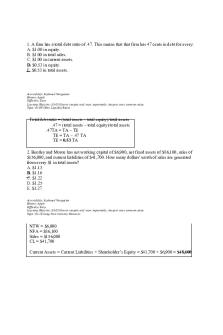10 - Test bank and multiple choice with answers PDF

| Title | 10 - Test bank and multiple choice with answers |
|---|---|
| Author | Justin Mcdonald |
| Course | Law Test bank |
| Institution | Tokyo City University |
| Pages | 3 |
| File Size | 38.4 KB |
| File Type | |
| Total Downloads | 73 |
| Total Views | 160 |
Summary
Test bank and multiple choice with answers...
Description
22. Which of the following cofactors is required for the conversion of succinate to fumarate in the citric acid cycle? A) ATP B) Biotin C) FAD D) NAD+ E) NADP+ C 23. In the citric acid cycle, a flavin coenzyme is required for: A) condensation of acetyl-CoA and oxaloacetate. B) oxidation of fumarate. C) oxidation of isocitrate. D) oxidation of malate. E) oxidation of succinate. E 24. Which of the following intermediates of the citric acid cycle is prochiral? A) Citrate B) Isocitrate C) Malate D) Oxaloacetate E) Succinate A 25. Anaplerotic reactions . A) produce oxaloacetate and malate to maintain constant levels of citric acid cycle intermediates B) produce biotin needed by pyruvate carboxylase C) recycle pantothenate used to make CoA D) produce pyruvate and citrate to maintain constant levels of citric acid cycle intermediates E) All of the above A 26. Intermediates in the citric acid cycle are used as precursors in the biosynthesis of: A) amino acids. B) nucleotides. C) fatty acids. D) sterols. E) All of the above E 27. The conversion of 1 mol of pyruvate to 3 mol of CO2 via pyruvate dehydrogenase and the citric acid cycle also yields _____ mol of NADH, _____ mol of FADH2, and _____ mol of ATP (or GTP).
A) 2; 2; 2 B) 3; 1; 1 C) 3; 2; 0 D) 4; 1; 1 E) 4; 2; 1 D 28. During the reaction of pyruvate carboxylase, CO2 is covalently attached to all the following except: A) phosphate. B) biotin. C) pyruvate. D) lysine. E) All of the above D 29. Entry of acetyl-CoA into the citric acid cycle is decreased when: A) [AMP] is high. B) NADH is rapidly oxidized through the respiratory chain. C) the ratio of [ATP]/[ADP is low D) the ratio of [ATP]/[ADP] is high. E) the ratio of [NAD+]/[NADH] is high. D 30. Citrate synthase and the NAD+-specific isocitrate dehydrogenase are two key regulatory enzymes of the citric acid cycle. These enzymes are inhibited by: A) acetyl-CoA and fructose 6-phosphate. B) AMP and/or NAD+. C) AMP and/or NADH. D) ATP and/or NAD+. E) ATP and/or NADH. E 31. During seed germination, the glyoxylate pathway is important to plants because it enables them to: A) carry out the net synthesis of glucose from acetyl-CoA. B) form acetyl-CoA from malate. C) get rid of isocitrate formed from the aconitase reaction. D) obtain glyoxylate for cholesterol biosynthesis. E) obtain glyoxylate for pyrimidine synthesis. A 32. A function of the glyoxylate cycle, in conjunction with the citric acid cycle, is to accomplish the: A) complete oxidation of acetyl-CoA to CO2 plus reduced coenzymes.
B) net conversion of lipid to carbohydrate. C) net synthesis of four-carbon dicarboxylic acids from acetyl-CoA. D) net synthesis of long-chain fatty acids from citric acid cycle intermediates. E) Both B and C are correct. E 33. The glyoxylate cycle is: A) a means of using acetate for both energy and biosynthetic precursors. B) an alternative path of glucose metabolism in cells that do not have enough O2. C) defective in people with phenylketonuria. D) is not active in a mammalian liver. E) the most direct way of providing the precursors for synthesis of nucleic acids (e.g., ribose). A...
Similar Free PDFs

Multiple choice with solutions
- 11 Pages
Popular Institutions
- Tinajero National High School - Annex
- Politeknik Caltex Riau
- Yokohama City University
- SGT University
- University of Al-Qadisiyah
- Divine Word College of Vigan
- Techniek College Rotterdam
- Universidade de Santiago
- Universiti Teknologi MARA Cawangan Johor Kampus Pasir Gudang
- Poltekkes Kemenkes Yogyakarta
- Baguio City National High School
- Colegio san marcos
- preparatoria uno
- Centro de Bachillerato Tecnológico Industrial y de Servicios No. 107
- Dalian Maritime University
- Quang Trung Secondary School
- Colegio Tecnológico en Informática
- Corporación Regional de Educación Superior
- Grupo CEDVA
- Dar Al Uloom University
- Centro de Estudios Preuniversitarios de la Universidad Nacional de Ingeniería
- 上智大学
- Aakash International School, Nuna Majara
- San Felipe Neri Catholic School
- Kang Chiao International School - New Taipei City
- Misamis Occidental National High School
- Institución Educativa Escuela Normal Juan Ladrilleros
- Kolehiyo ng Pantukan
- Batanes State College
- Instituto Continental
- Sekolah Menengah Kejuruan Kesehatan Kaltara (Tarakan)
- Colegio de La Inmaculada Concepcion - Cebu














